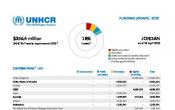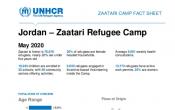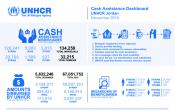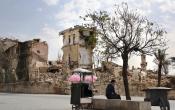Jordan
Operation: Jordan
Location
{"longitude":36,"latitude":31,"zoom_level":7,"iso_codes":"'JOR'"}
By clicking on the icons on the map, additional information is displayed.
The boundaries and names shown and the designations used on this map do not imply official endorsement or acceptance by the United Nations.
Key Figures
| 2020 planning figures | |
| 50,000 | people of concern receive legal assistance |
| 38,700 | households gain monthly, multi-purpose cash grants |
| 36,000 | people of concern are referred to secondary and tertiary medical care |
| 5,800 | refugee children benefit from best interests determinations |
| 1,600 | survivors of sexual and gender-based violence access psychological and social counselling |
| 2018 year-end results | |
| 428,410 | primary healthcare consultations provided through partners |
| 120,000 | Ministry of Labour work permits issued, including renewals, with around 50,000 work permits currently valid |
| 63,550 | people of concern received legal advice or assistance, with UNHCR intervening for some 1,610 people in detention |
| 32,500 | households were supported through cash assistance each month |
| 6,500 | best interest determinations conducted for children at risk |
| 6,390 | cases submitted for resettlement and 4,400 refugees resettled |
Latest Updates and Related Links
People of Concern
3%
Decrease in
2019
2019
| 2019 | 747,116 |
| 2018 | 769,260 |
| 2017 | 734,841 |

[["Refugees",693684],["Asylum-seekers",51305],["Others of concern",2127]]
Loading ...
Jordan
< Back
2019
{"categories":[2015,2016,2017,2018,2019,2020],"budget":[328.87751632,318.80353781,277.212605641,274.89660650999997,371.91846122000004,426.73744859],"expenditure":[208.74308994,218.32880034000002,238.50705437,224.59320141999999,213.88049035,null]}
{"categories":[2015,2016,2017,2018,2019,2020],"p1":[328.87751632,318.80353781,277.212605641,274.89660650999997,371.91846122000004,426.73744859],"p2":[null,null,null,null,null,null],"p3":[null,null,null,null,null,null],"p4":[null,null,null,null,null,null]}
{"categories":[2015,2016,2017,2018,2019,2020],"p1":[208.74308994,218.32880034000002,238.50705437,224.59320141999999,213.88049035,null],"p2":[null,null,null,null,null,null],"p3":[null,null,null,null,null,null],"p4":[null,null,null,null,null,null]}
Loading ...
CHOOSE A YEAR
- 2014
- 2015
- 2016
- 2017
- 2018
- 2019
- 2020
Year-end Overview
Operational Environment
While Jordan is not a signatory to the 1951 Refugee Convention, a Memorandum of Understanding establishes the parameters for cooperation between UNHCR and the Government of Jordan. Protection space for refugees continues to decrease as entry into the territory is severely restricted.In order to respond to the needs of refugees in Jordan, an increase in humanitarian assistance will be required. In 2019, UNHCR will continue to coordinate the refugee response, in collaboration with the Government of Jordan. UNHCR will maintain the coordination of the refugee pillar of the inter-agency appeal through the Regional Refugee and Resilience Plan (3RP). The United Nations Country Team has signed the United Nations Partnership Framework for the Sustainable Development Goal 2018-2022, where one refugee specific outcome has been included.
Over 80 per cent of refugees live outside camps and many have entered a cycle of asset depletion, with savings exhausted and levels of debt increasing. The Vulnerability Assessment Framework found that over 85 per cent of Syrian refugee households live under the Jordanian poverty line of USD 96 per person/month.
While access to legal employment for Syrian refugees has improved with some positive initiatives by the Government in relation to work permits, more is required in order to facilitate access to employment. UNHCR will continue to support refugee livelihoods and the right to work through advocacy, coordination and limited investments.
Overall, in 2019 UNHCR’s interventions in Jordan will focus on protection, cash assistance, livelihoods, health care, camp management and community mobilization. Vulnerability-based targeting for cash and other assistance will be strengthened. For the urban refugees, UNHCR’s multi-purpose cash assistance strategy will be a key component of UNHCR's comprehensive protection response aiming at decreasing economic and social vulnerabilities and reducing multi-dimensional poverty, in addition to income poverty. The operation will continue the nationalization process of partnerships.
The number of Iraqis, Sudanese, Somalis and Yemenis registering with UNHCR is expected to continue growing in 2019. UNHCR, in line with the views expressed by refugees in age, gender and diversity mainstreaming (AGDM) exercises, will continue efforts in implementing its “One Refugee” policy for all refugee groups under its protection, Syrian and non-Syrian alike, seeking to align protection and assistance policies with regard to various nationalities.
UNHCR will continue to monitor the situation in regards to returns, including ongoing preparedness measures.
Key priorities
In 2019, UNHCR will focus on:- Advocating on access to territory, the right to seek asylum, the principles of non-refoulement, family unity, and access to livelihood opportunities;
- Supporting the Government to provide security and protection to people of concern in accordance with international refugee protection principles through capacity-building initiatives;
- Providing multi-sectoral assistance to refugees in camps and cash assistance for up to vulnerable 38,000 families living in urban areas.






















